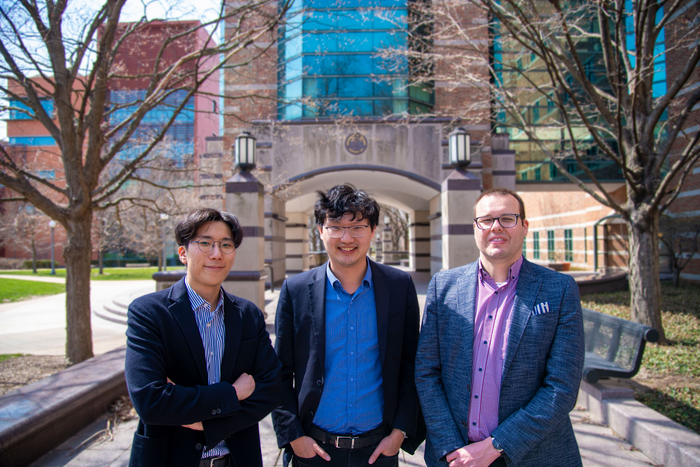Recognizing and separating enantiomers is a difficult task for chemical engineers — one might say it gives them a bit of a headache.

Credit: Beckman Institute Communications Office.
Recognizing and separating enantiomers is a difficult task for chemical engineers — one might say it gives them a bit of a headache.
Enantiomers are molecules with virtually identical compositions that mirror one another, like a left and right hand. In chemistry, this property is called chirality. Despite the similarities in their makeup, so-called left- and right-handed enantiomers often exhibit very different properties. Sometimes a drug has an enantiomer that causes undesirable effects. For example, certain drugs have one enantiomer that can cause a headache, while the other provides relief.
More than half of the top 500 drugs used in the United States are enantiomeric, according to Xiao Su, a researcher at the Beckman Institute for Advanced Science and Technology and an assistant professor of chemical and biomolecular engineering at the University of Illinois Urbana-Champaign. Su, alongside UIUC doctoral student Jemin Jeon and research scientist Johannes Elbert, recently developed a system to electrochemically distinguish one enantiomer from its twin.
The group’s development has significant implications for the drug manufacturing industry. Because new drugs are typically required to be racemic —containing an even 50-50 mixture of left- and right-handed enantiomers — their system would allow drug developers to more easily determine the ratio of enantiomers in a given drug, and eventually lead to more effective methods of separating them.
“When you’re producing a drug, you want to know how much of each enantiomer is in there,” Elbert said. “It’s like a form of quality control.”
Their paper appears in Advanced Functional Materials.
To effectively distinguish one enantiomer from its mirrored counterpart, the researchers used a versatile class of metal-containing polymers, also referred to as “metallopolymers,” that have been used for energy storage, water treatment, and selective separations. Historically, these metallopolymers have seen limited use for enantiomer recognition because they usually lack chirality, or handedness.
By adding a chiral center to the metallopolymers, researchers can use them to electrochemically sense two enantiomeric molecules: for example, the molecules used in valuable pharmaceuticals.
“The cool scientific advance here is that we’re able to prove that these redox polymers with chirality can be very good sensors and interact with their preferred enantiomers,” Su said.
Enantiomer recognition begins with chemically designed building blocks on the polymer, referred to as “redox-centers.” Redox-centers allow the polymers to undergo reduction and oxidation (hence the polymers’ portmanteau name) by electron transfer. This process allows the redox-centers from the polymers to selectivity bind, and thus sense, an enantiomer by changes in current and potential.
“We’ve basically created a class of chiral metallopolymers that can serve as platform for many enantioselective studies going forward,” Su said.
Furthermore, the study shows for the first time a phenomenon referred to as supramolecular chirality, an intriguing feature in which the polymer displays more chirality than the redox-center building blocks themselves. The researchers leverage this supramolecular chirality to amplify the sensing effect, an efficient upgrade from past sensing methods.
“With electrochemical methods, there’s no need to add anything external like chemical additives,” Su said. “It’s a sensing method purely based on electrical input and electrical readouts, making it flexible and modular to use.”
Although studies on chiral sensors already exist, many are limited to one-time use. But the Illinois researchers’ sensor is mobilized onto an interface, allowing it to be reused.
And while their newly developed sensor method is still considered proof of concept, the researchers have already identified their next steps.
“Now that we have proved the sensing and recognition properties, the next step is to translate these properties for separation” Su said. “Right now our system works really well for chiral sensing, but beyond that, we want to create devices and even better materials to be able to fully purify enantiomers.”
The paper titled “Chiral Metallopolymers for Redox-Mediated Enantioselective Interactions” can be accessed online at https://doi.org/10.1002/adfm.202301545
Media contact: Jenna Kurtzweil, [email protected]
Journal
Advanced Functional Materials
DOI
10.1002/adfm.202301545
Article Title
Chiral Metallopolymers for Redox-Mediated Enantioselective Interactions
Article Publication Date
2-Apr-2023
COI Statement
The authors declare no conflict of interest.




